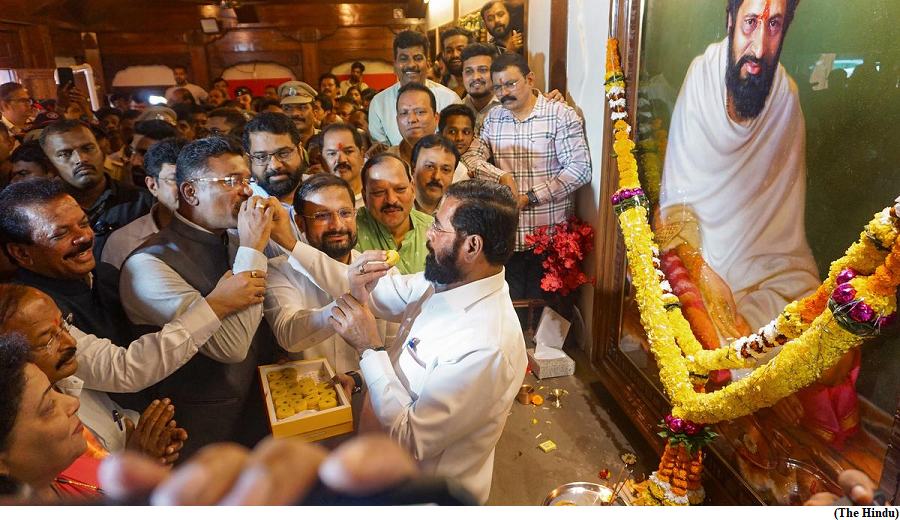Understanding the Tenth Schedule (GS Paper 2, Polity and Constitution)

(GS Paper 2, Polity and Constitution)
Why in news?
- The Maharashtra Assembly Speaker has refused to disqualify 40 MLAs of the Eknath Shinde faction after recognising it as the real Shiv Sena.
- He held the appointment of whip by this group as valid.
- He also did not disqualify 14 MLAs of the Uddhav Balasaheb Thackeray (UBT) group due to technical reasons under the Tenth Schedule.
Why was the Tenth Schedule made?
- The defections of legislators during the 1960s and 70s from their parent parties created political instability in many States, bringing down elected governments.
- Therefore, to ensure the stability of elected governments, the 52nd constitutional amendment introduced the ‘anti-defection’ law through the Tenth Schedule in 1985.
- This Schedule provides that a member of a House of Parliament or State legislature who voluntarily gives up the membership of their political party or votes against the instructions of their party in a House are liable for disqualification from said House. This instruction with respect to voting is issued by the ‘whip’ of a party.
- A ‘whip’ is a member of the ‘legislature party’ in a House who is appointed as such by the respective ‘political party’. The ‘political party’ is the entire organisation of a party including the legislators, while the ‘legislature party’ is only the members of a political party in a House of Parliament or State legislature.
Exceptions:
- The Tenth Schedule originally provided for two exceptions that would not render the members liable for disqualification.
- First, one-third members of the ‘legislature party’ splitting to form a separate group (para 3).
- Second, merger of their ‘political party’ with another party that is approved by two-third members of its ‘legislature party’ (para 4). However, considering the need to strengthen the ‘anti-defection’ law, para 3 was omitted in 2003.
What are the issues involved?
- With the deletion of para 3, there have been instances of two-third members of a legislature party ‘practically’ defecting but claiming to be the original political party in order to escape disqualification. There have also been instances where more than two-third members of a State ‘legislature party’ of a national political party merged themselves with another political party to escape disqualification.
- This happened in September 2019, in Rajasthan, when all six Bahujan Samajwadi Party MLAs merged themselves with the Congress Party and in September 2022, in Goa, when eight out of 11 Congress MLAs merged themselves with the BJP.
- The authority to decide on the disqualification of members is vested in the Speaker of the House. While they are expected to perform this constitutional role in a neutral manner, the past instances have hardly inspired confidence with Speakers favouring the ruling dispensation.
- The Supreme Court in K. M. Singh versus Speaker of Manipur (2020), recommended that Parliament amend the Constitution to vest these powers in an independent tribunal headed by judges.
What happened in Maharashtra?
- In June 2022, a faction of the Shiv Sena headed by Eknath Shinde moved with 37 of the 55 MLAs and claimed to be the real Shiv Sena. It appointed Bharat Gogawale as its whip.
- However, the UBT faction claimed that they were the original political party and that Sunil Prabhu of its faction will continue to be the whip.
- The Speaker has now recognised the Eknath Shinde faction as the real Shiv Sena and held the appointment of whip by this group as valid. This was based on the strength of members of the Shinde faction and the party’s 1999 constitution.
- The Speaker based on this ruling refused to disqualify 40 MLAs of the Shinde faction. He also refused to disqualify 14 MLAs of the UBT group as the whip instructions from Bharat Gogawale could not be physically served on them.
What are the reforms needed?
- The Supreme Court in Sadiq Ali versus Election Commission of India (1971), laid down the three-test formula for determining which faction is to be recognised as the original political party by the Election Commission.
- These are aims and objects of the party; its affairs as per the party’s constitution that reflect inner party democracy; and majority in the legislative and organisation wings.
- The first test is subject to competing claims by rival groups. But it is lack of inner party democracy that results in most of these defections. In fact, the Election Commission in February 2023, recognised the Eknath Shinde faction as the real Shiv Sena, solely based on votes polled by legislators supporting Eknath Shinde in the Maharashtra Assembly elections of 2019.
- An authoritative Supreme Court judgment in these matters and setting up of an independent tribunal to decide on disqualification of members will reduce the ambiguities surrounding the Tenth Schedule.
- The real reform required is institutionalising internal democracy through regular inner-party elections in our political parties with strict monitoring by the Election Commission.


